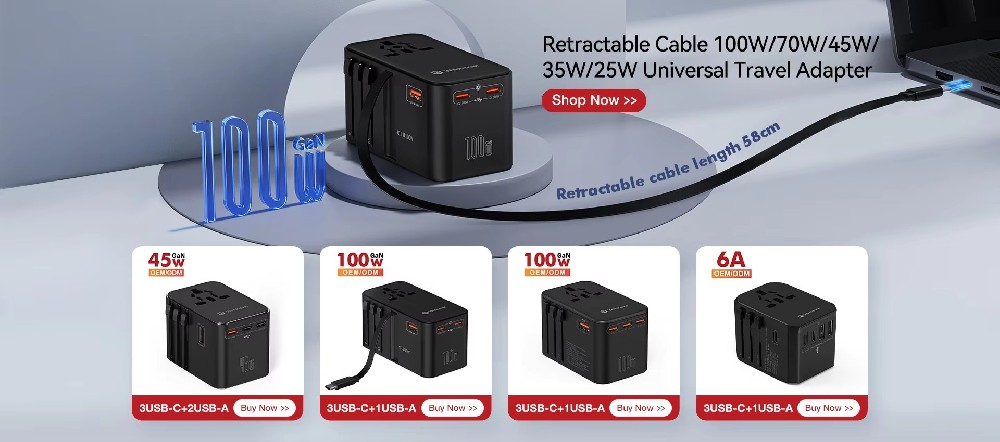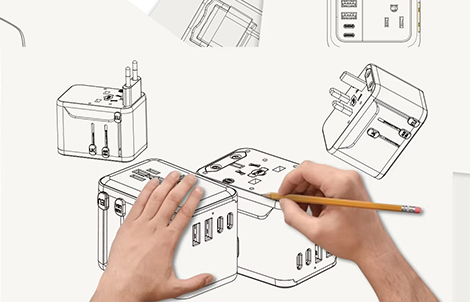Industry news
Conquer European Outlets: Your Essential Guide to the Perfect Europe Plug Adapter
Writer: admin Time:2025-07-15 14:47:38 Browse:167℃
The Shock of Landing: Europe's Different Plugs & Power
You step off the plane in Paris, buzzing with excitement. You pull out your phone to call a rideshare... and your heart sinks. The charger plug won't fit the weird, round holes in the hotel wall socket! Sound familiar? Over 60% of North American travelers encounter power issues on their first trip to Europe, often due to incompatible plugs (Source: European Travel Commission, 2023 Survey). Trying to jam your flat pins into a Schuko socket (that's the common Type F plug in Europe!) is frustrating and risky. This simple Europe plug adapter is your first, non-negotiable travel essential. Forget juggling dead devices; let's fix this.
What Exactly is a Europe Plug Adapter? Your Key to Power
Think of it as a physical translator for your plugs. A Europe plug adapter doesn't change electricity itself; it simply allows the prongs of your device's charger (like a US Type A or UK Type G plug) to connect securely and safely into the different socket types used across continental Europe (primarily Type C, E, and F). This compact travel gadget is your bridge to powering up. However, remember: it only solves the plug shape problem, not the voltage difference! Most of Europe runs on 230V, unlike North America's 110V-120V.

Core Functions: More Than Just Making It Fit
So, what does a good European travel adapter actually do?
Physical Compatibility: Enables your device's plug to connect physically to Type C (2 round pins), Type E/F (Schuko, 2 round pins with top/bottom grounding clips), found everywhere from Spain to Sweden.
Safe Connection: Provides a secure fit, preventing loose plugs that can spark or damage sockets. Quality adapters use fire-resistant materials.
Compact Portability: Designed to be small and lightweight, easily slipping into your pocket or carry-on. Ditch the bulk!
(Sometimes) Basic Surge Protection: Some models include minimal surge protection, offering a small buffer against power spikes.
Real-World Power Scenarios: When Your Adapter Saves the Day
Imagine these common travel moments:
The Business Sprint: Land in Frankfurt for a crucial meeting. Your US laptop charger plugs into your Type F plug adapter, connecting securely to the German Schuko outlet. Phone charges via USB on your laptop. Crisis averted, presentation ready!
The Family Adventure: In a Rome apartment with limited outlets. Your Europe plug adapter with built-in USB ports lets you charge two phones and a tablet simultaneously from one socket, while the camera battery charges nearby. Happy kids, happy parents!
The Backpacker's Stop: At a Lisbon hostel. Your compact universal adapter configured for European sockets powers your phone and power bank overnight. Ready to explore again tomorrow! By 2025, over 70% of portable devices will charge via USB-C, making adapters with these ports vital (Source: Statista, USB-C Adoption Forecast, 2024).
Europe Adapter vs. Other Options: Choosing Wisely
| Feature | Basic Europe Plug Adapter | Universal Travel Adapter | Voltage Converter |
|---|---|---|---|
| Fits EU Sockets | ✅ (Type C/E/F) | ✅ (Includes EU) | ❌ (Needs separate adapter) |
| Handles Voltage? | ❌ (Plug shape only) | ✅ (Regulation common) | ✅ (Converts 110V<>230V) |
| USB Ports | Sometimes (1-2) | ✅ (Multiple, often PD) | ❌ |
| Works Outside EU? | ❌ | ✅ (150+ countries) | ✅ (With adapter) |
| Cost | $ (Low) | $$ (Moderate) | $$$ (High) |
| Best For | EU-only trips, basic needs | Frequent global travel | High-wattage appliances |
Using Your Europe Plug Adapter: A Simple 5-Step Guide
Using it safely is easy. Follow these steps:
Identify Your Device Charger: Check its label! Crucially, look for "Input: 100-240V". Most modern phone/laptop chargers are dual-voltage. If it only says "Input: 110V" or "120V", you'll need more than just an adapter (see Warnings!).
Configure the Adapter (if universal): If using a universal adapter, slide or rotate the prongs to form the Type C or Type F (Schuko) plug configuration for Europe.
Plug FIRMLY into the Wall Socket: Ensure the adapter prongs are fully inserted into the European outlet. It should feel secure, not wobbly.
Plug Your Charger into the Adapter: Insert your device's charger plug (e.g., US plug) into the socket on the Europe plug adapter.
Connect Your Device & Monitor: Plug your device (phone, laptop) into its charger. Check for charging indicators. Don't overload the adapter or socket.
Avoid These Costly Europe Adapter Mistakes!
WARNING: Protect your gear! Avoid these common errors:
Ignoring Voltage: This is critical! A basic European plug adapter ONLY changes the plug shape. Plugging a 110V-only device (like an old hair dryer or cheap coffee maker) into Europe's 230V power via just an adapter will likely FRY the device instantly and could cause a fire. Only plug in dual-voltage devices (100-240V input).
Forcing the Plug: If the adapter doesn't slide easily into the socket, STOP. Double-check you have the correct plug type (Type C or F). Forcing it can break the socket or adapter.
Overloading the Socket/Adapter: Don't plug multiple high-wattage devices into one adapter or wall outlet using splitters. Check wattage limits.
Assuming USB Ports Handle Everything: While convenient, USB ports on adapters have power limits (e.g., max 2.4A per port). Charging multiple tablets might be slow.
WARNING: Protect your gear! Avoid these common errors:
Ignoring Voltage: This is critical! A basic European plug adapter ONLY changes the plug shape. Plugging a 110V-only device (like an old hair dryer or cheap coffee maker) into Europe's 230V power via just an adapter will likely FRY the device instantly and could cause a fire. Only plug in dual-voltage devices (100-240V input).
Forcing the Plug: If the adapter doesn't slide easily into the socket, STOP. Double-check you have the correct plug type (Type C or F). Forcing it can break the socket or adapter.
Overloading the Socket/Adapter: Don't plug multiple high-wattage devices into one adapter or wall outlet using splitters. Check wattage limits.
Assuming USB Ports Handle Everything: While convenient, USB ports on adapters have power limits (e.g., max 2.4A per port). Charging multiple tablets might be slow.
My Voltage Wake-Up Call in Berlin
I learned the hard way. Early in my travels, I brought a cheap, old hair dryer to Berlin, thinking my basic plug adapter for Europe was enough. I plugged it in... POP! A small flash, a burning smell, and a dead dryer. Thankfully, only the dryer died, not the adapter or socket. It was a stark lesson: Adapters handle shape, not magic voltage fixes! Now, I always check device input voltage first and rely on dual-voltage gear. My current universal travel adapter with USB-C PD keeps my essentials charged safely.
Europe Plug Adapter FAQs Answered
A: Almost certainly NO. Most US hair dryers are 110V-120V only. Plugging them into 230V European power with only a Europe plug adapter will destroy the dryer and is a fire hazard. You need a dual-voltage hair dryer (check label for 100-240V) OR a heavy-duty voltage converter (not recommended for high-wattage appliances).
A: Type C (Europlug) has two round pins and is ungrounded, common for low-power devices like phone chargers. Type F (Schuko) has two round pins plus top and bottom metal grounding clips, used for higher-power appliances and is the standard socket in Germany, Austria, Netherlands, etc. A good European travel adapter will fit both securely.
A: Yes, absolutely! The UK (Type G) uses completely different plugs (three rectangular pins) than continental Europe. A basic Europe plug adapter won't work in the UK. You'll need a specific UK adapter or a universal travel adapter that includes Type G configuration.
A: Proceed with caution. While convenient, very cheap adapters might lack proper safety certifications (look for CE, RoHS, ETL) or use flimsy materials that can overheat or break. Investing in a reputable brand from an electronics store is safer for your expensive gadgets.
A: Choose a European plug adapter with multiple USB ports (including USB-C PD) and at least one AC pass-through socket. This lets you charge your phone/tablet via USB while also plugging in your laptop charger. Look for GaN technology for compact size and higher power.
H2: Your Europe Power Prep Checklist: Don't Get Caught Out!
Before you head to the airport, tick these boxes:
Packed Europe Plug Adapter(s)? Confirm you have enough for your devices/hotels.
Checked Device Voltage? Verified every charger says "Input: 100-240V"?
Left High-Wattage 110V Appliances? Hair dryers, straighteners, coffee makers? Leave them or buy dual-voltage ones locally.
UK Stopover? Packed a UK-specific adapter if needed?
Tested Adapter at Home? Briefly plugged it in with a European charger (if you have one) or just checked the fit?
Packed Necessary Cables? USB-C, Lightning, etc.?
Knows Max Wattage? Reviewed limits for adapter/sockets if using high-power devices?
Power Up and Explore Europe with Confidence
Don't let a simple plug difference drain your travel joy. The right Europe plug adapter is a small, essential tool that unlocks seamless charging for your devices. Understanding its role – solving the physical plug shape but not the voltage – is key to avoiding disasters. Pair it with dual-voltage devices, and you're golden. Invest in a reliable European travel adapter, perhaps one with handy USB ports, and ditch the pre-trip power anxiety. Embrace the convenience, stay connected, capture every moment, and enjoy your European adventure, fully charged! Bon voyage and happy charging!
CATEGORIES
LATEST NEWS
- What are the differences in plugs (chargers) among countries around the world?
- Answers to frequently asked questions by customers
- Worldwide Plug Adapter with Fast Charging for Singapore South Korea
- The Ultimate Universal Travel Adapter with USB-C for Business Trips
- Choosing a Travel Plug Adapter for Germany France Business Trips
CONTACT US
WhatsApp: xxxxxx
Phone: 18128986700
Email: zhozuoplug@hotmail.com
Add: Dongguan City, Guangdong Province, China
